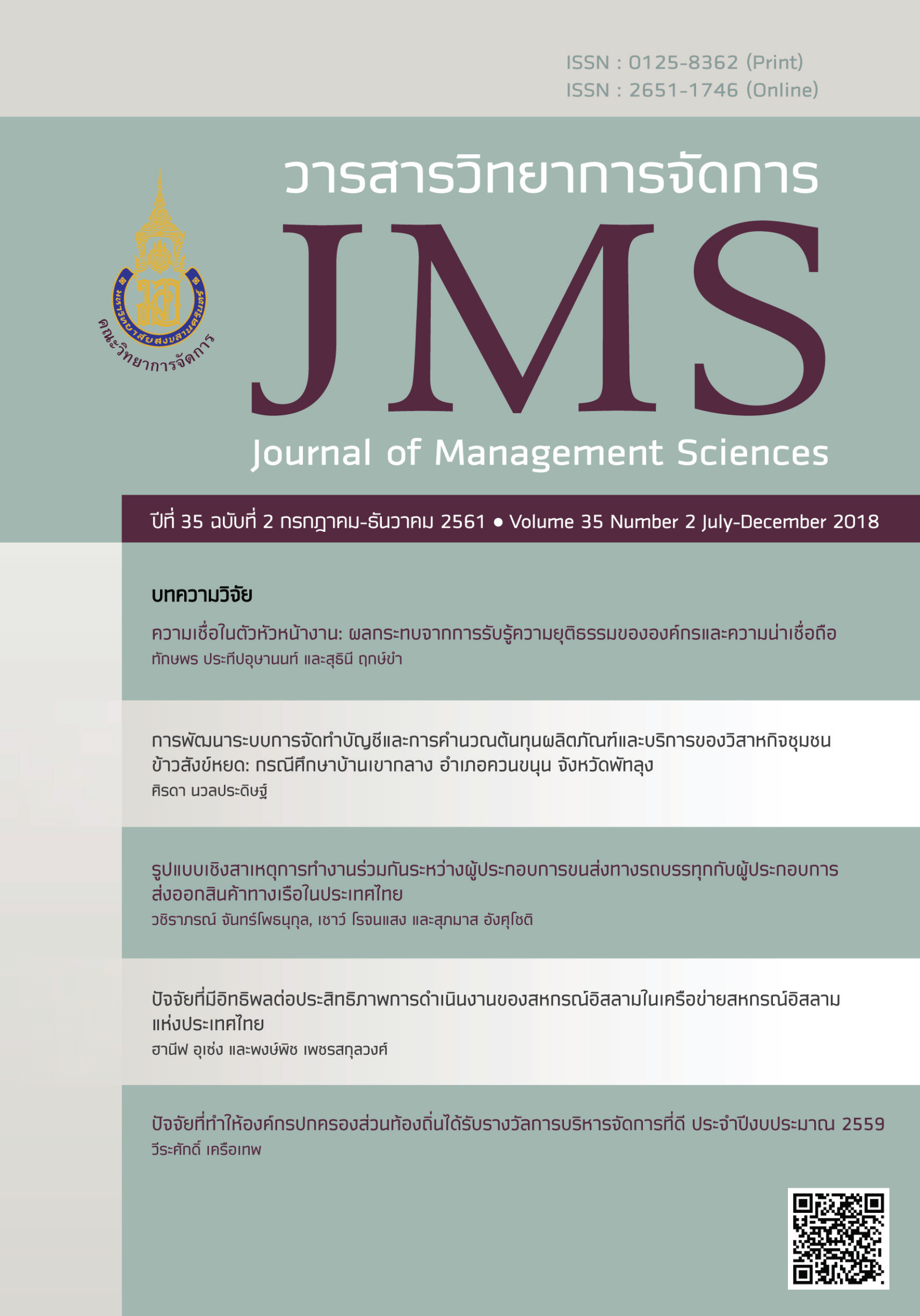Causal Model of Collaboration between Trucking Companies and Export Shipping Companies in Thailand
Main Article Content
Abstract
Collaboration between companies influences their performance. This relationship can be important in helping executives understand the best ways to work together. The objective of this study was to demonstrate the causal model for collaboration and company performance between trucking companies and export shipping companies in Thailand. This study utilized mixed method approach using survey for collecting data from 149 trucking companies and 165 export shipping companies, and then descriptive statistics and structural equation model (SEM) were used for data analysis. In-depth interviews with 9 key informants were used to collect qualitative data and content analysis was used to analyze such qualitative data. Results indicate that trust has a strong influence on company performance for trucking companies while trust, collaboration, and sustainability have influence on company performance for export shipping companies, respectively. However, commitment has no influence on company performance for both companies. These results provide practical implications for executives in both companies to improve company performance by focusing on building trust In addition, executives should focus on building engagement for both executives and employee levels.
Article Details

This work is licensed under a Creative Commons Attribution-NonCommercial-NoDerivatives 4.0 International License.
All published articles are SJMS’s copyright. The editorial board allows all published articles to be copied, excerpted, or disseminated with academic citation.
References
Barney, J. (1991). Firm resources and sustained competitive advantage. Journal of Management, 17(1), 99-120.
Barratt, M. (2004). Understanding the meaning of collaboration in the supply chain. International Journal Supply Chain Management, 9(1), 30-42.
Cao, M., & Zhang, Q. (2011). Supply chain collaboration: Impact on collaborative advantage and firm performance. Journal of Operation Management, 29(3), 163-180.
Duffy, R., & Fearne, A. (2004). The impact of supply chain partnership on supplier performance. Journal of Logistics Management, 15(1), 57-71.
Elkington, J. (1994). Enter the Triple Bottom Line. Retrieved January 3, 2016, from https://www.johnelkington.com/archive/TBL-elkington-chapter.pdf.
Fawcett, S. E., Jones, S. L., & Fawcett, A. M. (2012). Supply chain trust: The catalyst for collaborative innovation. Business Horizons, 55(2), 163-178.
Fugate, B. S., Davis-Sramek, B., & Goldsby, T. J. (2009). Operational collaboration between shippers and carriers in the transportation industry. The International Journal of Logistics Management, 20(3), 425-447.
Gibson, B. J., Rutner, S. M., & Keller, S. C. (2002). Shipper-carrier partnership issues, ranking and satisfaction. International Journal of Physical Distribution & Logistics Management, 32(8), 669-681.
Goldratt, E. M. (1990). What is this Thing Called Theory of Constraints and How should it be Implemented? New York: North River Press.
Ha, B. C. (2007). Strategic Collaboration with Motor Carrier and the Effect on Managers' Perceptions of Firm Performance. Thesis (PhD.) George Washington University, United States of America.
Ha, B. C., Park, Y. K., & Cho, S. (2011). Suppliers' affective trust and trust in competency in buyers: Its effect on collaboration and logistics efficiency. International Journal of Operations & Production Management, 31(1), 56-77.
Hudnurkar, M., Jakhar, S., & Rathod, U. (2014). Factors affecting collaboration in supply chain: a literature review. Procedia-Social and Behavioral Sciences, 133, 189-202.
Karia, N. (2013). Green innovation in logistics industry: sustainability and competitive advantage. In K. S. Soliman (Ed.), IBIMA conference 20th (pp. 456-462). Kuala Lumpur: IBIMA.
Kasikorn Research Center (2017). Logistics businesses 4.0 push shipping. Retrieved October 19, 2017 from https://www.kasikornbank.com/th/business/sme/SMEKnowledge/article/KSMEAnalysis/Documents/TransportationWithLogistic40.pdf
Lai, K. H., Ngai, E. W. T., & Cheng, T. C. E. (2004). An empirical study of supply chain performance in transport logistics. International journal of Production economics, 87(3), 321-331.
Lai, K. H., & Wong, C. W. (2012). Green logistics management and performance: Some empirical evidence from Chinese manufacturing exporters. Omega, 40(3), 267-282.
Lambert, D. M., Emmelhainz, M. A., & Gardner, J. T. (1999). Building successful partnerships. Journal of Business Logistics, 20(1), 165-181.
Mentzer, J. T. (2001). Managing supply chain collaboration. Supply Chain Management, 83-84.
Min, S., Roath, A. S., Daugherty, P. J., Genchev, S. E., & Chen, H. (2005). Supply chain collaboration: what’s happing? The International Journal of Logistics Management, 16(2), 237-256.
Ministry of Commerce. (2017). Export structure. Retrieved March 2, 2017, from https://www2.ops3.moc.go.th/
Morgan R. M., & Hunt. S. D. (1994). The commitment-trust theory of relationship marketing. Journal of Marketing, 58(3), 20-38
Nyaga, G. N., Whipple, J. M., & Lynch, D. F. (2010). Examining supply chain relationships: do buyer and supplier perspectives on collaborative relationships differ? Journal of operations management, 28(2), 101-114.
Penrose, E. T. (1959). The Theory of the Growth of the Firm. New York: Sharpe.
Perotti, S., Zozini, M., Cagno, E., & Micheli, G. J. (2012). Green supply chain practices and company performance: the case of 3PLs in Italy. International Journal of Physical Distribution & Logistics Management, 42(7), 640-672.
Piboonrungroj, P., & Disney, S. M. (2012). Supply chain collaboration, inter-firm trust and logistics performance: Evidence from the tourism sector. Retrieved June 3, 2016, from https://ssrn.com/abstract=2050703
Premeaux, S. R. (2009). The Similarity of motor carriers’ and shippers’ perceptions of the carrier choice decision improve. Journal of the Transportation Research Forum, 48(1), 39-47.
Simatupang, T. M., & Sridharan, R. (2002). The collaborative supply chain. International Journal of Logistics Management, 13(1), 15-30.
Simatupang, T. M., & Sridharan, R. (2004). Benchmarking supply chain collaboration: An empirical study. Benchmarking: An International Journal, 11(5), 484-503.
Spekman, R. E., & Carraway, R. (2006). Making the transition to collaborative buyer–seller relationships: An emerging framework. Industrial Marketing Management, 35(1), 10-19.
Supply Chain Council. (2012). Supply Chain Operations Reference Model version 9.0. United States of American.
Wei, H. L., Wong, C. W., & Lai, K. H. (2012). Linking inter-organizational trust with logistics information integration and partner cooperation under environmental uncertainty. International Journal of Production Economics, 139(2), 642-653.
Williamson, O. E. (1979). Transaction-cost economics: The governance of contractual relations. Journal of Law and Economics, 22(2), 233–261.
Wiratchai N. (1999). LISRELL Model: Statistical Analysis for Research. Bangkok: Faculty of Education, Chulalongkorn University
Whipple, J. M., & Russell, D. (2007). Building supply chain collaboration: a typology of collaborative approaches. The International Journal of Logistics Management, 18(2), 174-196.

